Oberlin Alumni Magazine
Spring 2012 Vol. 107 No. 2
Balloon to the Edge of Space
PROFESSOR CHRIS MARTIN LAUNCHES A TELESCOPE TO THE HEAVENS FROM THE BASEMENT OF THE PHYSICS LAB
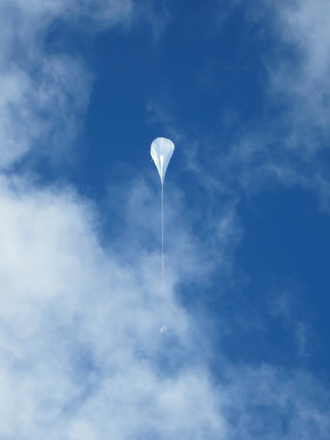
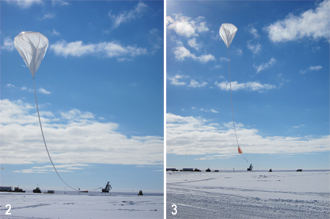 2. Once the right amount of helium has been pumped into the balloon, it is released, but the gondola, which carries the telescope, stays tethered to an enormous truck called the Boss. When the balloon is fully inflated, the Boss moves along with it on the ground, trying to match the balloon's speed and drift. Once the team is satisfied that the gondola won't swing or lose control, it's released from the Boss.
2. Once the right amount of helium has been pumped into the balloon, it is released, but the gondola, which carries the telescope, stays tethered to an enormous truck called the Boss. When the balloon is fully inflated, the Boss moves along with it on the ground, trying to match the balloon's speed and drift. Once the team is satisfied that the gondola won't swing or lose control, it's released from the Boss.3. The balloon lifts the gondola higher and higher. It will eventually reach about 125,000 feet.
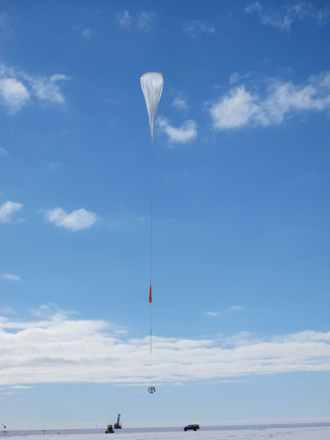 The balloon lifts the gondola higher and higher. It will eventually reach about 125,000 feet.
The balloon lifts the gondola higher and higher. It will eventually reach about 125,000 feet.
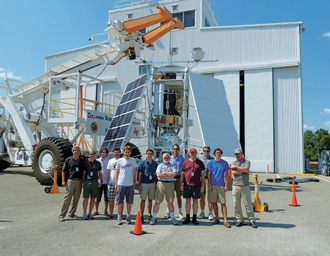 The telescope team included Martin, third from right, and student Thomas Shaw '12, second from right
The telescope team included Martin, third from right, and student Thomas Shaw '12, second from right (Courtesy of Chris Martin)
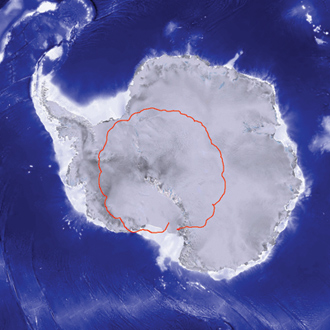 The nearly-perfect circle drift path of the STO, which was launched into a seasonal high altitude wind pattern called the Polar Vortex
The nearly-perfect circle drift path of the STO, which was launched into a seasonal high altitude wind pattern called the Polar Vortex
Chris Martin believes in pursuing one’s passions, no matter where they lead. As associate professor of physics and astronomy at Oberlin, Martin’s own passions have led him all the way to the bottom. The bottom of the world, that is.
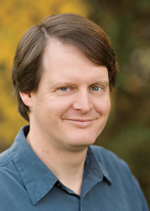
Associate professor of physics
and astronomy Chris Martin
(Headshot by Tanya
Rosen-Jones '97)
"I’ve been going to Antarctica since 1999," he says. He "wintered-over" in 2001 and 2003, living among the 50 or so year-round residents of the isolated science outpost at the Amundsen-Scott South Pole Station. There, he studied ways in which new stars form and he delved into the dynamics of the Milky Way galaxy—research sometimes called "Antarctic astronomy."
For Martin, the South Pole is more than just a great spot for serious stargazing. Though Antarctica is "a stark and forbidding place," Amundsen-Scott is a close-knit community of people "with a wide range of backgrounds. It was a real pleasure to get to know carpenters and plumbers just as well as doctors and scientists," he says. Martin has experienced his own extremes at the station: he was there when he found out—hours after the fact—about the September 11, 2001, attacks, and it was there he proposed to his wife, during a 2003 visit.
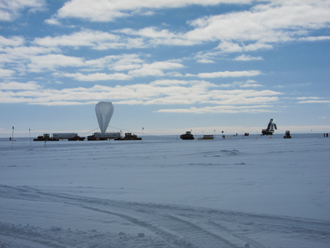 The January 15 launch of the Stratospheric Terahertz Observatory (STO), a balloon-borne telescope, in Antarctica. The balloon, which inflates to the size of a football stadium, begins being pumped with helium from two tanker trucks.
The January 15 launch of the Stratospheric Terahertz Observatory (STO), a balloon-borne telescope, in Antarctica. The balloon, which inflates to the size of a football stadium, begins being pumped with helium from two tanker trucks.
Higher Education
Just months ago, on January 15, Martin worked on the successful launch of the Stratospheric Terahertz Observatory (STO), a balloon-borne telescope funded by NASA. As part of an international team, Martin and his students helped build and launch the telescope from McMurdo Station on the edge of the Ross Ice Shelf off the coast of Antarctica. For two weeks, STO flew above the Antarctic coast, observing star-forming regions in frequencies of light not accessible from the ground.
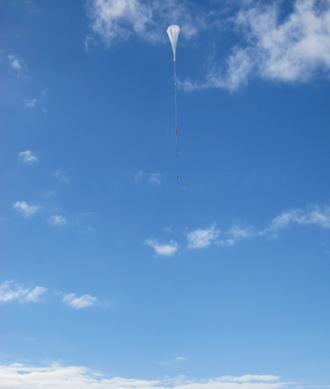 The balloon lifts the gondola higher and higher. It will eventually reach about 125,000 feet.
The balloon lifts the gondola higher and higher. It will eventually reach about 125,000 feet.
Remarkably, Martin monitored the launch and controlled the two-week flight from Oberlin, working from a small room in the basement of the Wright physics lab. "I ended up being sort of like the flight director. I was operating it 24 hours a day, seven days a week for two weeks straight. I had my little mission control center. It was in the basement, but it was also on my laptop. It was at home; it was on the road; it was wherever it needed to be."
The telescope would eventually reach an altitude of 125,000 feet, housed in the gondola below a helium balloon the size of a football stadium. "You are above 99 percent of the Earth’s atmosphere," he says. "The sky is black; the horizon is curved. You’re right on the edge of space."
"YOU ARE ABOVE 99 PERCENT OF THE EARTH'S ATMOSPHERE. THE SKY IS BLACK; THE HORIZON IS CURVED. YOU'RE RIGHT ON THE EDGE OF SPACE."
Over the next two weeks, STO would drift in an almost perfect circle, coming to rest just 100 miles from the launch site. The flight path was nearly flawless because the team had successfully caught a seasonal high altitude wind pattern called the Polar Vortex.
"It made a very nice little circle," he says. "We launch from Antarctica because of the high probability of getting that circle." For just this reason, NASA launches two or three missions each season from McMurdo.
Such balloon-borne telescopes, says Martin, provide a unique learning environment for undergraduates; STO is a collaboration between Oberlin, the University of Arizona, and the Applied Physics Lab at Johns Hopkins University, among others. "Balloon projects are called sub-orbital missions, and they’re considered by NASA to be training grounds for graduate students and undergrads to learn the kinds of skills they need to go off and do bigger missions at some point."
And compared to satellite projects, Martin adds, balloon projects are affordable. Satellites, like the Herschel Space Telescope launched by the European Space Agency in 2009 (another project in which Martin and his students are participating), can cost billions of dollars. As Martin notes, "you build a really nice, but expensive satellite, but that cost means that you can’t let a student learn how to do anything."
Like most balloon projects, the STO instrument was built with parts from prior telescopes. The body of the telescope and the mirror, for example, were originally built to detect missiles for a project called Starlab, part of the Reagan-era Star Wars program.
Oberlin senior Thomas Shaw created much of the command-and-control software for the STO project. David Lesser ’10, who was involved in the project as a student and now works with it as a graduate student at the University of Arizona, helped build much of the hardware.
Star Maps
Though many people think of astronomy as a science focused on stars, it isn’t the stars that interest Martin as much as the vast dark regions between them—the interstellar medium. His work is about mapping those spaces.
The interstellar medium is filled with clouds of gas and dust that are too cold to be seen by the naked eye but warm enough to be visible at the far infrared (IR) end of the spectrum. Here, IR astronomy reveals a complex environment in which enormous clouds slowly collapse to form newborn stars.
"WE WANT TO KNOW THE ENVIRONMENT THAT BRAND NEW STARS WILL COME OUT OF."
"We want to know the environment that brand new stars will come out of," Martin explains. "There are a lot of unanswered questions about how stars form. How did our sun come to be? It sounds like it ought to be pretty simple, but it turns out not to be."
The technology of IR astronomy is uniquely suited to study light in this part of the spectrum, but Martin is a radio astronomer. "The far infrared turns out to be exactly the same end of the spectrum that the high end of radio frequencies are found."
Although radio astronomy is technologically more difficult than IR astronomy, Martin is biased. "The benefit of radio astronomy is that you get a lot of frequency resolution," he explains. "You get a very fine-grained knowledge of what exactly the colors are of the light."
He is working, as he describes it, "at the very, very high end of radio astronomy. Terahertz is sort of the holy grail of radio astronomy."
But it is difficult to do radio astronomy from the ground. "The atmosphere is essentially opaque to these frequencies," Martin observes. To see the warm glow of the interstellar medium you need to get a telescope up above the atmosphere—which is just what the balloon projects accomplish.
But ballooning is as much about art as science. And not all missions are as lucky as Martin’s. Consider the ill-fated BLAST telescope. In 2006, after executing a perfect circle and drifting slowly to rest just southwest of McMurdo, its parachute failed to release as designed. Caught by the wind, the parachute dragged the gondola for more than 150 miles across the surface of Antarctica, leaving a debris trail of little bits of telescope in its wake. "Eventually the whole thing fell into a crevasse and is no more," says Martin.
"Ours came down all in one piece. It’s actually in pretty good shape, so we’ll fly it again," he adds. "That’s another benefit of balloon missions over satellite missions; you can do them over and over again. You can learn lessons from the first time that you can apply to the second time. With satellites, it’s got to be perfect; if not, it’s space junk."
Kirk Warren is an Oberlin-area freelance writer.

Want to Respond?
Send us a letter-to-the-editor or leave a comment below. The comments section is to encourage lively discourse. Feel free to be spirited, but don't be abusive. The Oberlin Alumni Magazine reserves the right to delete posts it deems inappropriate.